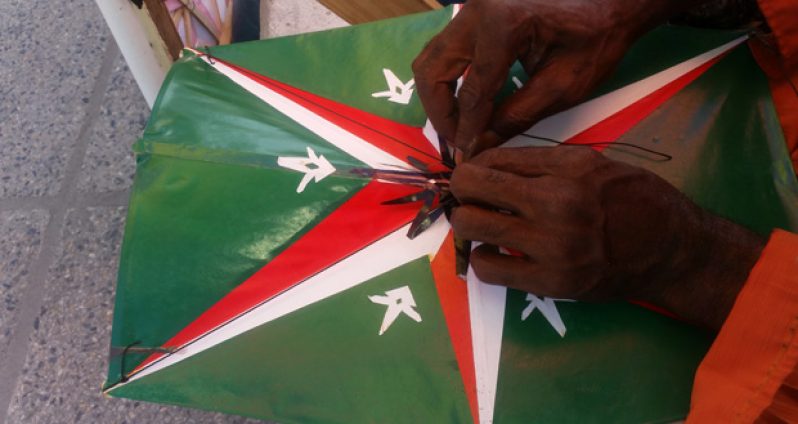By Jasmaine Payne
ONE of the many joys of being Guyanese is the simple, often homemade pleasures that served as significant parts of a fulfilled childhood. As children, everyday materials furnished our playtime, from using the seeds of the ‘awarra’ or ‘kuru’ to play the backyard game ‘gam’, or matchboxes and corks to create tiny toy cars, to even using old strips of rubber for the legendary pastime of ‘chinee’.

It is without a doubt that Guyanese have forever been known as an ingenious people. As such, it is not surprising that such ingenuity would trickle over to holidays such as Easter.
In fact, in the days of old, it was common practice that in the place of a ready-made kite, which, for many, was a luxury often not seen, the ‘caddy-ol’-punch was eminent.
The story goes that the ‘caddy-ol’-punch – which is said to have taken its name from the method of punching the pointers through the holes of the paper — served as a blissful substitute for children whose parents could not afford the wooden kites that were being sold.
As a result, for many a young Guyanese, Easter started with the ‘caddy’. Young boys would make almost a religion of constructing these kites, using leaves from their old exercise books, pointers from the household pointer broom, thread, and some glue.
And while, in many cases, it was just a pastime, for those who had no other option, the ‘caddy’ was the only kite they’d have for Easter, so it had to be made perfectly.
THE PERFECT CADDY
The key to the perfect ‘caddy’, the one that would soar high enough that it could be left flying overnight, is in the ‘loop’, kitemakers say. Once knotted perfectly, the loop can give the makeshift concoction unflawed balance. Though their profession is embedded in the making of the traditional star-point kites, many kitemakers admit to having their start with the very simple but complex ‘caddy’.
“You make the holes with the pointers: In, out, in, out; roughly about a half-inch away. And you make an ‘X’; a perfect ‘X’,” one veteran kitemaker said.
“We use to draw that ‘X’ out on that paper with a pencil, and mark off the holes evenly,” he said. “And then you use the pointers and guide them in and out along the lines.
“And that was our excitement. And we use to fly a ‘caddy’ whole day! We would never pull it down! We’d fly it through the night, once the rain don’t fall. Then we’d wake up the next morning, and your ‘caddy-ol’-punch’ is still in the air.”
THE EVOLUTION
As time progressed, makers of the ‘caddy-ol’-punch’ soon graduated to making ‘pointer kites’, which were exact replicas of their wooden superiors, but with pointer frames.

With the pointer kites ready to soar, the aim then centred on whose kite would make the most noise, and whose would get cut from the sky in a brutal game of ‘cut-away-kite doan-vex’.
What this meant was that kites were equipped with razor blades on their tails and wreaked havoc in the sky in a battle for which kite flew the highest.
Many remembered these times fondly, and have said that while it was a tough game, it was all in the fun of things.
But alas, the days and nights of the caddy’s flight, and that of its pointer-infused sibling have very well been put to rest.
With the ‘star-point’ kites now within pocket reach, and the proliferation of the cheap and effective Chinese ‘bird kites’, the option to use an exercise book page and pointers to construct a makeshift creation has undoubtedly lost its appeal.
“It’s two different generations,” one kitemaker said, adding:
“I made caddies when I was about five or six, but a six-year-old now can pick up a smart-phone or ‘tablet’ and show you so many things.
“So, it’s a more advanced generation. But that excitement, where Easter involved making your kite with your own hands, is totally different now; and that’s because of the advancements in technology.”
ON THE MARKET
Today, the ‘star-point’ kites remain a constant on the market, and are known for their durability and their guaranteed ability to fly.
Yet, the kitemakers still make room for the readymade ‘bird’ kites, which they said are used mostly by schools in the last days before the Easter holiday, and as a last-minute resort by fathers who don’t want the hassle of having to raise a ‘star-point’ kite. Then there are the unorthodox but less popular ‘box’ kites, which kitemakers say do garner some attention from persons looking for something more unique, but which do not sell as quickly as the traditional ‘star- point’.
But, for persons who grew up in the age of the ‘caddy-ol’-punch, their minds will always saunter back to the days of climbing the ‘gamma-cherry tree’ to get glue, and finding a ‘balla (a piece of wood)’ around which you’d ball your string, and running to no end up and down the street, trying to get your hand-made invention up in the sky. Because, the moment it went up there, even if it lasted only but a minute, it was the ultimate accomplishment; at that very moment, in their own little way, that was how children in those days really connected with Easter.




.png)









